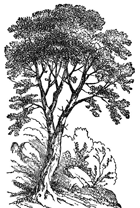Terrestrial Communities - Teacher's Guide |
Episode Overview Patrice looks at, tundra, rainforest, grassland, taiga, temperate deciduous forest and desert biomes. She then joins Dave to learn how the red-tailed hawk is adapted to a variety of habitats. In the third segment, we take an up-close look at the desert. Finally, Laura and Marshall take a hike with David Publicover of the Appalachian Mountain Club and look at the diversity of plant life along the trail. Patrice looks at, tundra, rainforest, grassland, taiga, temperate deciduous forest and desert biomes. She then joins Dave to learn how the red-tailed hawk is adapted to a variety of habitats. In the third segment, we take an up-close look at the desert. Finally, Laura and Marshall take a hike with David Publicover of the Appalachian Mountain Club and look at the diversity of plant life along the trail.
Program ObjectivesStudents will:1. Students will understand that environments support a diversity of living organisms that all share limited resources 2. Describe different biomes and explain why certain plants and animals are found in certain biomes. 3. Describe some unique characteristics of the red-tailed hawk. 4. Students will describe some unique characteristics of the desert. Vocabulary
Previewing ActivityPut a list of biomes on the board or on a wall chart and have students list plant and animal life that can be found in each. |
Post-Viewing Activities1. Have students further research a biome and report their findings back to the class. 2. Have students identify characteristics of particular plant and animal life that helps them survive in certain biomes. 3. Have students select a biome and then design an animal or plant that would be well-adapted for that biome. Have the student explain the adaptations that their plant or animal has that would help it survive in the biome.
Hands-On: Saving WaterIn this episode of NatureWorks, students learned about desert environments and learned that living organisms in the desert have unique adaptations to retain moisture. In this activity students will explore ways to conserve water. Materials Neededsponges ProcedureThis activity can be done in small groups or individually. Give each student or group a sponge and have them weigh the sponge. Next, have the students saturate their sponge with water and then weigh the sponge again. Over a period of a week, have the students devise ways to conserve the water in their sponges using natural materials. For example, they might cover their sponge with leaves or bark. At the end of the week have them weigh their sponges and record how much water was lost. Have them discuss which techniques for preserving water worked the best and why.
|
